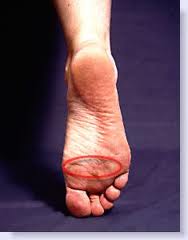Foot - metatarsalgia
What is metatarsalgia?
Metatarsalgia is a general term used to describe pain in the ball of the foot. The pain most commonly affects the 2nd, 3rdand 4th metatarsal heads (the ends of the metatarsal bones where they meet the phalanges, or toe bones), or more rarely, in the 1st and 5th metatarsal heads (at the base of the big toe and the little toe respectively). The pain is due to excessive pressure on one or more of the metatarsal heads, which press on the surrounding soft tissues causing them to become inflamed. A callus (or so-called hyper-keratosis) may form under the overloaded metatarsal.
What causes it?
Some congenital factors make you more likely to suffer from metatarsalgia: a metatarsal bone longer, or lower, than the others; high-arched feet; and flat feet. Other foot conditions can also lead to metatarsalgia: hammer toes, bunions, or hallux rigidus and medical conditions such as osteo or rheumatoid arthritis.
Incorrect footwear such as high heels, narrow shoes or inadequately cushioned soles can all increase the overload on the metatarsal heads. The problem can become worse as you grow older as the fat pad under the foot becomes thinner. Being overweight can also exacerbate the foot pain.
How does it feel?
The pain typically feels like a bruise deep in the ball of your foot, or as if there is a stone caught under your forefoot. As the condition worsens, you may have swelling on the sole of your foot, or tenderness on the top of the affected joint. The area may throb if you’ve walked or stood for a long time. A callus of thickened skin may form on the sole of your foot under the affected joint.
Diagnosis
Your doctor will ask you about your medical history and will examine your foot. He may ask for other tests (X-rays whilst standing, an MRI scan) if he suspects there is another condition such as a bone fracture or damaged tendons/ligaments causing the pain.
Treatment – conservative
Your doctor may prescribe orthotics (special insoles) to cushion, and spread the pressure away from the affected area. He will also check that you are using the correct footwear. If these treatments do not solve the problem in the long term – particularly if the pain is caused by an abnormal metatarsal structure or alignment – your doctor will recommend surgery to realign the metatarsal bones.
Treatment – surgical
– Metatarsal Osteotomy: your surgeon will make an incision over the affected bone(s). He will then remove a small piece of the metatarsal to ensure that it is the correct length, fixing the bone in position with an absorbable pin. He will correct any other foot conditions (bunions, hammer toes etc.) at the same time to ensure that the metatarsalgia does not recur.
Rehabilitation after surgery
Normally patients will stay in hospital overnight. You can walk straight away after the operation wearing an orthopaedic shoe, which you will need to wear for 3 weeks before you can go back to wearing normal shoes. After 14 days your doctor will remove the stitches. You will need to go back to your doctor with X-rays of the foot 1, 3 and 12 months after the operation.
When will I be back to normal?
You can go back to office work after 3-4 days, and manual work after 4 weeks. You can start driving after about a week, and start light sporting activity (swimming, cycling etc.) after 3 weeks. You should wait 2-3 months before returning to sports that put intense pressure on the ball of your foot.
